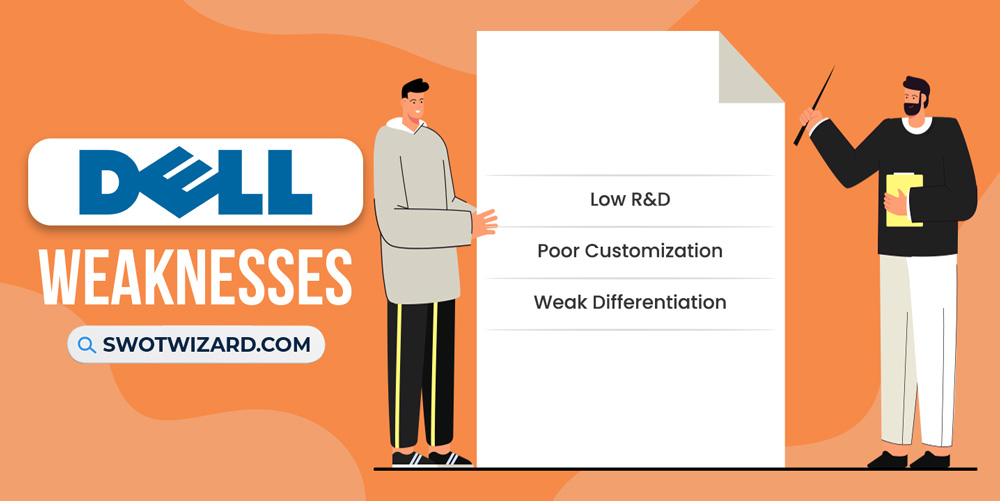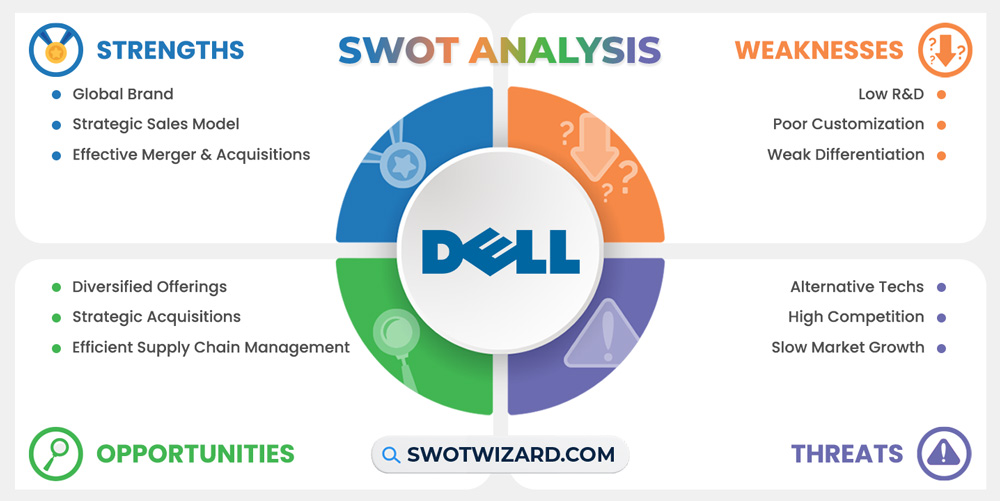Dell is one of those companies that you will find in your home, school, workplace, or regular burger or pizza joint from where you order. Because of customization options and other benefits, it has become one of the biggest companies worldwide, which we will dissect in this Dell SWOT analysis.
Dell: Company Overview
| Company | Dell Inc. |
| Industry | Technology |
| Founded | 1984 |
| Founder | Michael Dell |
| CEO | Michael Dell |
| Headquarter | Round Rock, Texas, US |
| No. of Employees | 133,000+ |
| Annual Revenue | $101.6 billion (FY 2022) |
| Website | dell.com |
The company didn’t start long ago; founded in 1984 by Michael Dell, Dell Technologies became a global tech giant within a few years. The company’s origin story began in Michael Dell’s dorm room at the University of Texas at Austin, initially named “PC’s Limited,” with a mere $1,000 investment.
In 1996, they started selling computers directly to consumers over the internet, revolutionizing how computers were sold, and it changed everything for the company and became one of the biggest tech giants. Now, Dell boasts an employee base of around 133,000 and generates substantial revenue, consistently ranking among the top technology companies.
Product & Services of Dell
Personal computers | Servers | Peripheral
Dell Competitors
Lenovo | Apple | Samsung | HP | Compaq | Acer | IBM
Did You Know?
Dell was the first major computer manufacturer to offer a free recycling program globally for used Dell products.
Strengths – Dell SWOT Analysis

Global Brand: Among all the brand ranking lists, Dell enjoys strong brand affinity. As per the most prestigious rankings, the company ranks 31st on the Fortune US 500 and 10th in the America’s Most Responsible Companies list as of 2022. Besides ranking, the company is also recognized worldwide.
Strategic Sales Model: By selling directly to customers and via digital channels, Dell maintains lean and targeted sales operations compared to competitors. The direct sales model productivity measured in revenue per sales rep has grown consistently year-over-year, and it not only enables customization but also ensures a swift response to evolving consumer demands.
Effective Merger & Acquisitions: If we look at the last ten years of data, it shows that the company has become a dominant force in enterprise solutions, amplifying Dell’s portfolio and revenue streams significantly. The major event was the acquisition of EMC Corporation in 2016 for $67 billion, gaining ownership of VMware and bolstering its infrastructure solutions.
Weaknesses – Dell SWOT Analysis

Low R&D: The company’s R&D expenditures as a percentage of revenue have trailed rivals like HP, Lenovo, and Apple over the last five years. Dell invested $2.865B, just around 2% of its revenue in R&D in 2022. Even though it’s increasing, it’s not enough to compete in this cutthroat market.
Poor Customization: Although the brand built its brand on customized PCs, it has become table stakes. Surveys indicate only a tiny percentage of customers see Dell as better than rivals at product customization. Owing to its direct sales model, Dell struggles to offer services like on-site support and has relatively lengthy delivery turnarounds compared to rivals.
Weak Differentiation: Within its core PC and server hardware portfolio, Dell faces pricing pressures and a lack of differentiation in an increasingly commoditized market. Dell’s client solutions segment operating income declined in the last few years compared to other rivals, indicating falling margins.
Opportunities – Dell SWOT Analysis

Diversified Offerings: The company can leverage its hardware design and manufacturing capability to develop products and integrated solutions for high-growth segments like edge computing, analytics, AI, and 5G infrastructure. The global edge computing market is projected to reach $139.58B by 2030, indicating a sizable opportunity for Dell to diversify its revenue.
Strategic Acquisitions: With a strong balance sheet after divesting VMware ownership, Dell can look for strategic acquisitions to quickly gain technology IP and expertise in cloud, security, analytics, and software. Potential acquisition targets like the ones they already have in their acquisition portfolio include pure-play cybersecurity and cloud consultancy firms to complement Dell’s infrastructure strength.
Efficient Supply Chain Management: The organization maintains a lean, just-in-time oriented supply chain, which proved resilient even amid COVID disruptions and chip shortages. As supply uncertainty continues, Dell can solidify its supply chain advantage to ensure higher fill rates and production flexibility compared to rivals.
Threats – Dell SWOT Analysis

Alternative Techs: With the growth in public cloud infrastructure from AWS, Azure, and GCP, enterprise demand for on-premise servers is slowing, and it is hitting Dell’s core server infrastructure business. Besides, the company’s server and networking business revenue declined by a massive chunk in the last four years.
High Competition: Dell faces tough competition from diversified giants like HP and Lenovo in PCs and servers while also confronting expanded offerings from AWS, Google, and Oracle in cloud computing. It is like a war in every segment with the giant fishes in the sea, and it’s brutal. As a result, the company’s multipronged competition across its product portfolio limits its options to differentiate itself.
Slow Market Growth: The worldwide PC market saw shipments decline by over 9% Year-over-Year in Q3 2022. Not to mention, enterprise IT spending is also projected to grow by just 3% in 2023. Without diversification, Dell’s revenue growth prospects remain constrained by the stagnation in its core PC and server markets.
[Bonus Infographic] SWOT Analysis of Dell

Recommendations for Dell
Here are some recommendations for Dell that can help the company strategically:
- The company should identify critical targets in security, analytics, and cloud consulting to gain relevant capabilities and cross-selling opportunities rapidly.
- Another thing they should definitely do is increase R&D spending focused on high-growth segments like 5G infrastructure, multi-cloud solutions, and edge computing.
- Complementing its in-house capabilities with alliances can aid market expansion for Dell, like joint GTM partnerships with communication service providers around 5G and edge computing, which is one opportunity to consider.
- To diversify its offerings and products, Dell can transition more of its offerings to as-a-service consumption models to align with customer preferences for opex spending and subscription models amid cloud proliferation.
Frequently Asked Questions (FAQs)
Where is Dell’s headquarters?
Dell’s headquarters is in Round Rock, Texas.
Is Dell made in China?
Yes, Dell is made in China.
Final Words on Dell SWOT Analysis
Dell’s strengths in brand reputation and direct sales are foundational, yet the dependence on the PC market and competitive pressures pose challenges. The company’s opportunities lie in diversification. To navigate threats from alternative tech and intense competition, Dell must pivot towards higher-growth segments like IT services while innovating to stay agile in a dynamic market, ensuring sustained relevance and growth.
References
- Wikipedia contributors. (n.d.). Dell. Wikipedia.




